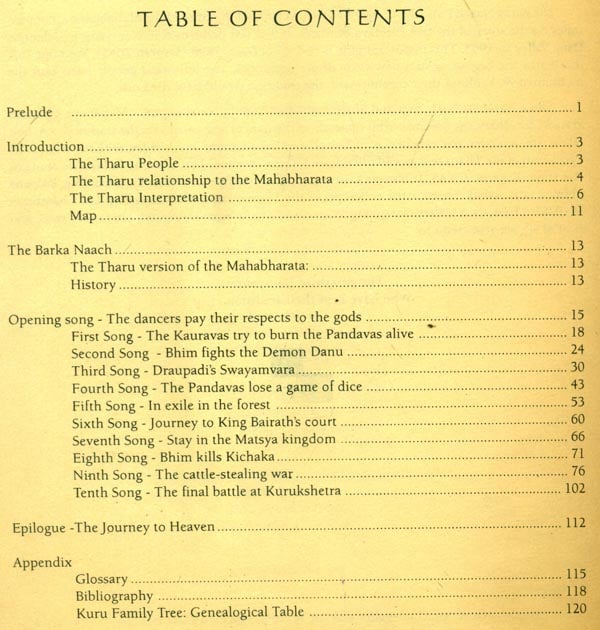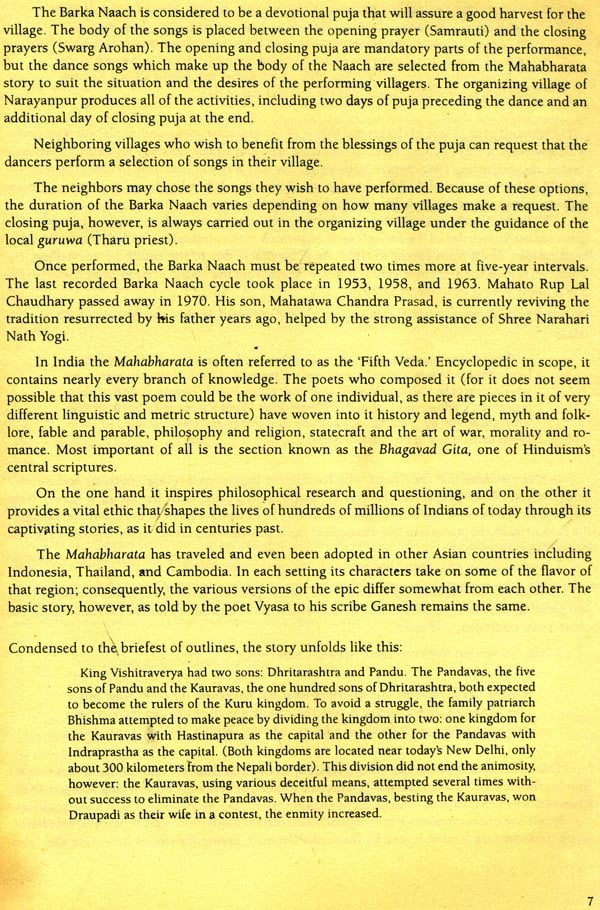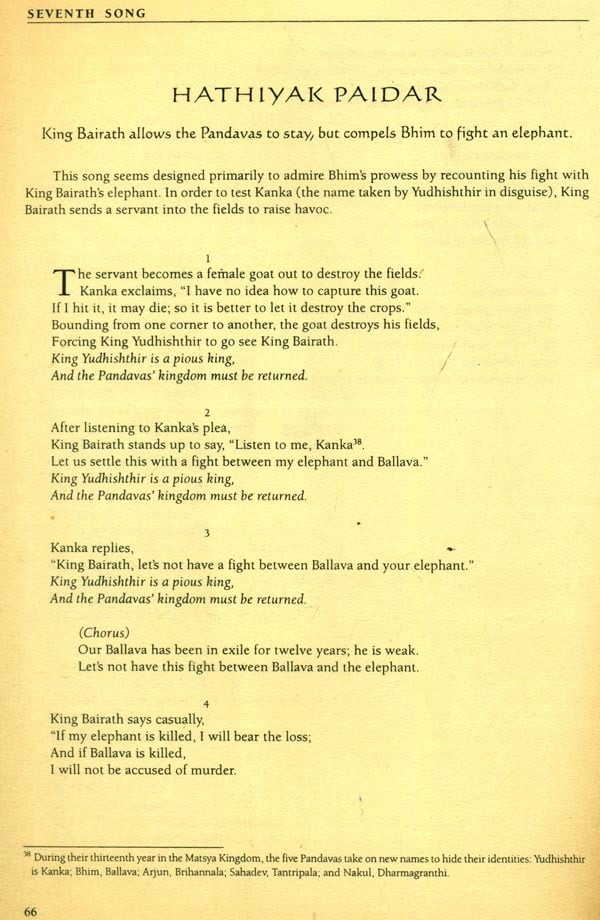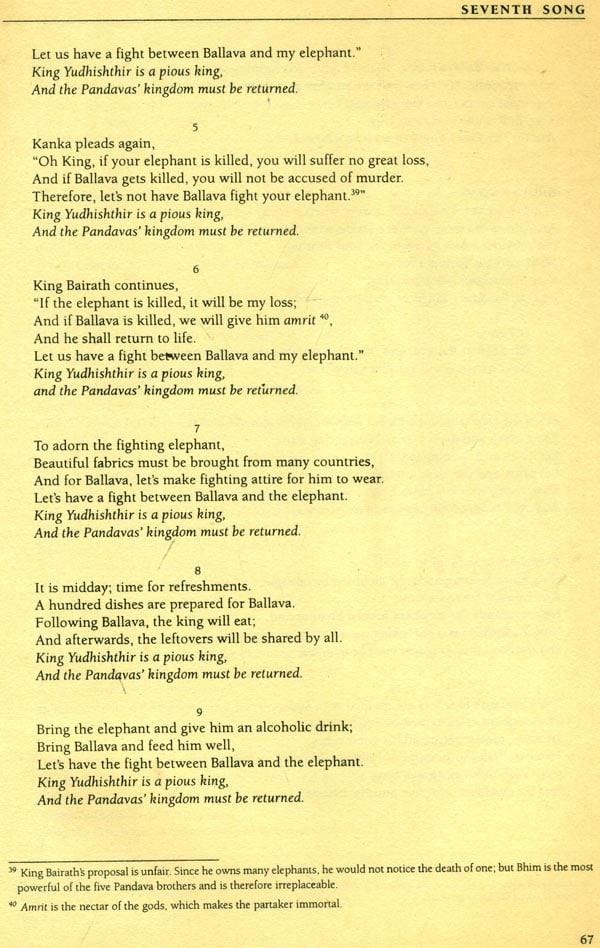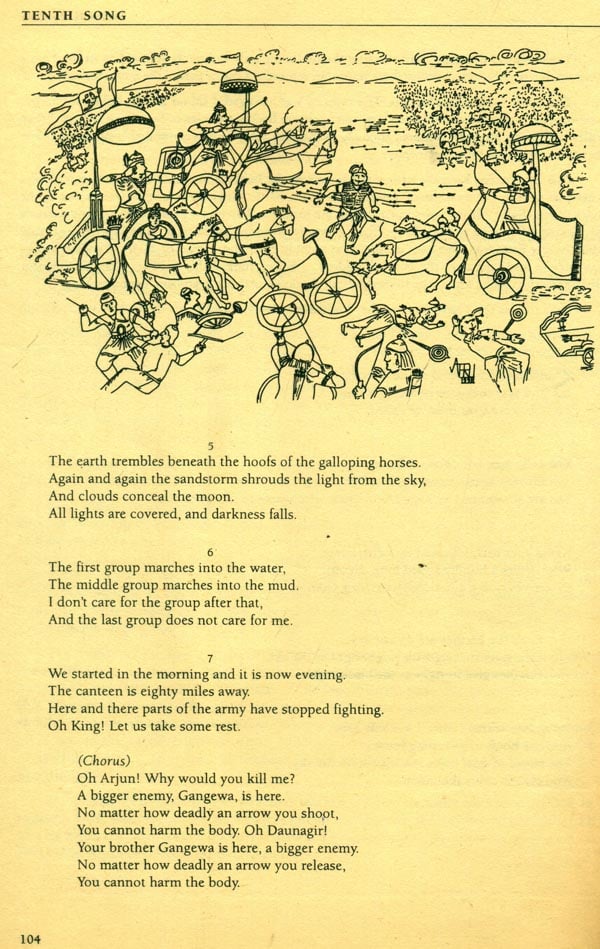
Mahabharata-The Tharu Barka Naach (An Old and Rare Book)
Book Specification
| Item Code: | NAP815 |
| Author: | Dinesh Chamling Rai |
| Publisher: | Himal Books, Nepal |
| Language: | English |
| Edition: | 1998 |
| ISBN: | 9780966674200 |
| Pages: | 124 (8 B/W Illustrations) |
| Cover: | PAPERBACK |
| Other Details | 10.00 X 7.50 inch |
| Weight | 300 gm |
Book Description
In 1993, Kurt Meyer and Pamela Deuel, on a routine research trip in Nepal’s Terai, learned that farmers in one Tharu village had once performed a folk version of the Mahabharata, known in Tharu as the Barka Naach," the big dance." Meyer and Deuel learned that although the tradition had died out, a few old villagers still recall the songs and dances of this important religious festival. When they were told that a collection of songs and song fragments existed in writing, they decided to help revive the tradition and to publish the collection of songs. In autumn 1998, the villagers of Dang Valley performed the Baka Naach for the first time since the early 1960’s.tradition holds that, to be ritually correct, the complete. It is hoped that the 1998 festival will lead to the continuing revival of the Barka Naach among the Dangaura Tharu in future years.
Few outsiders have seen this other Nepal or the folk traditions of the Tharu, whose unique artistic tradition of the Barka Naach is published here for the first time. As Mahatawa Chandra Prasad Chaudhary told Meyer and Deuel, "We are afraid of losing our Tharu culture, which is deteriorating day by day. The main purpose of reviving the dance is to maintain Tharu culture so it can continue to survive. For this purpose my father with the help of Naraharinath Yogi and Badrinath Yogi, wrote a book describing the role of the Barka songs in Tharu culture."
Who are the Tharu of Nepal? They are believed to be the first people to live in the Tarai, the tropical low lands that border India. Few people realize that the Tharu are Nepal[s fourth ethnic group in Nepal, numbering over one million people. Their origins are unknown, but whatever their beginnings, they successfully settled in the dense jungle, developing a remarkable resistance to the deadly malaria, which kept other people out until DDT eliminated the disease in the 1960s. the Tharu became the cultivators of the Tarai and turned the region into the breadbasket of Nepal.
Born in Zurich, Switzerland, Meyer received his architectural degree from the Swiss Federal Insitute of Technology [ETH] and practiced architecture in Los Angeles for 40 years. He has been a Himalayan explorer for twenty years and a collector of rare books on Central Asia and the Himalayan countries. In 1992, he sold his architectural practice and devotes full time to researching the architectural design and artistic traditions of the Tharu of Nepal.
Pamela Deuel has lived in Nepal since 1993, researching, living with and recording the customs of Tharu; Born in California, she graduated from Stanford University in journalism and has an MA in Multicultural education. She worked for a decade in the environmental movement in the United States. For four years, Meyer and Deuel travelled to remote corners of Nepal’s Tarai low lands in search of the folk art, architecture and traditions of the Tharu, knowing that the changes of modern society would quickly reach even remote settlements. The first people to documents the diversity of Nepal’s Tharu material culture, they were welcomed in hundreds of Tharu homes from Nepal’s eastern border to its western edge. An acclaimed exhibition of their work was held at the Indigo Gallery in Kathmandu in 1997. Research scholars affiliated with the Center for Nepali and Asian Studies of Nepal’s Tribhuvan Uniersity. Meyer and Deuel are working on two other books about the Tharu. The second book, also published in 1998, is The Kings of Nepal and the Tharu, a rare collection of previously unpublished royal grant documents bestowed on Tharus from the founding of the nation of Nepal up to modern times. The third book is an overview of Tharu art and architecture with full colour photography.
It is autumn The fields of Dang Valley are golden yellow, and the heavy stalks of rice sway gently in the breeze. In a few days, the Dangaura Tharu farmers will perform, the Barka Naach in song and dance. Tharu families will come from miles around to watch this Tharu celebration of the Mahabharata. The last time, the Barka Naach was performed was over 30 years ago, and many Tharu will witness this great tradition for the first time in their lives.
It is not known when the Barka Naach, the Dangaura Tharu version of the Mahabharata, was first performed in Dang Valley. We do know, however, that at the beginning of this century a farmer and village leader, Mahatawa Rup Lal Tharu of Jhalaura, decided he would undertake the job of preserving the Barka Naach. Knowing that many segments of the songs were missing, he together with local Tharu guruvas, collected loose manuscript;. Since he was an illiterate farmer, Rup Lal Tharu first had to teach himself to read and write. He then wrote down the story in its original Tharu language as a single manuscript. Before he died in 1970, Rup Lal passed the manuscript along to his son, Mahatawa Chandra Prasad Tharu, the current village leader, who now carries on his father’s commitment to preserve the tradition of the Barka Naach.
In 1922, Rup Lal first reconstructed the entire performance of the Barka Naach into a cohesive whole. Then, assisted by a number of Tharu Guruwas, he organized performances for over 50 years, from 1922 until 1963. With the aid of Naraharinath Yogi, local Tharu staged many performances until the 1960s, when there were no longer sufficient funds available to finance the considerable cost of a complete performance.
In 1993, Kurt Meyer and Pamela Deuel, guided by Professor Drone Rajaure,came across the Tharus’ predicament on a routine research trip during which they met Mahatawa Chandra Prasad Tharu, the son of Mahatawa Rup Lal. Mahatawa Chandra is one of the very few Tharu still living today who know the songs by heart and who possess a transcript of the Tharu songs. To revive the traditional performance of the Barka Naach, Meyer and Deuel provided financial support to the farmer so they could produce a shortened version designed to demonstrate their skills. It was an unforgettable and moving experience, when in February 1994 Tharu families from Dang and the surrounding hills converged for a weekend of tradition. This abbreviated "practice" version of the play drew over 3,000 local men, women and children, many of whom travelled many hours on foot or by bus to attend.
The Tharu are now in the process of regenerating the traditional Barka Naach offerings. The 1998 performance is expected to be a new beginning in the cycle of performing this important puja. Mahatawa Chandra best explains the importance of these efforts.
"We are afraid of losing our Tharu culture which is deteriorating day by day. The main purpose of recording a small part of the dance on video is to maintain the Tharu culture so it can continue to exist. Also for this purpose my father, with help of Naraharinath Yogi and Badrinath Yogi, has written a book describing the role of the Barka songs in the Tharu culture."
To the Tharu, the performance of the Barka Naach, the Big Dance, is a devotional presentation offered to the gods to ensure good health, a plentiful harvest and good fortune for the village.
**Contents and Sample Pages**
